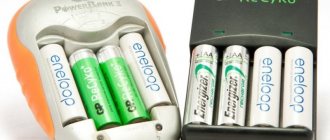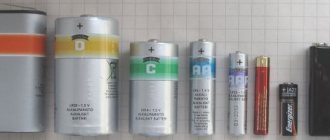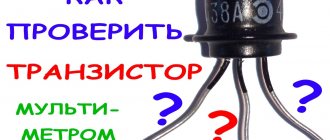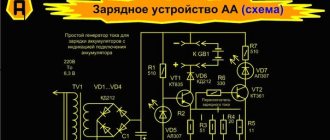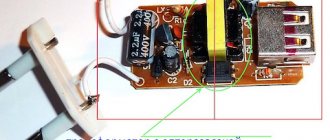The term “battery” from an electrical engineering book is a source of electric current in which several electrochemical elements are connected. As a result of the chemical process occurring in the “body”, electricity is generated. In everyday life, batteries are anything that provides direct current, that is, capable of powering or charging an electronic device. Power supplies are not rechargeable, so they do not last forever. Let's look at the design of the battery, on what principle it works and what types it comes in.
A battery works by converting chemical energy into electrical energy.
Principle of operation
Arriving at the store, hundreds of different power sources are found on the shelves. They differ in technical characteristics, but they are united by the principle of operation. Each battery has plus and minus poles and an electrolyte in the form of a liquid or dry substance - these are the main elements. Electricity moves from “+” to “-”.
Cathodes, designated as “minus”, work as reducing agents - energy comes to them from the anode. During the chemical reaction, ions are formed, which move inside the battery in a special medium - an electrolyte. During the life of the power source, other substances are formed in it, and the electrodes are deformed - it shrinks.
This is the principle of operation of a classic battery. The processes occurring in it are irreversible. This means that the power source cannot be recharged.
Oxidation and reduction
The flow of charges is necessary to power electrical devices. Redox potential is the type of chemical reaction that makes this flow possible. There are two main phenomena in it:
- The atoms of the first element are oxidized, thereby giving up their electrons.
- Atoms of the second element easily accept electrons and are reduced.
Combining both electron-deficient and abundant materials looks like a great way to ensure a stable flow of charge. Naturally, not all elements are equally easily oxidized or reduced. The most commonly used metals (such as lithium, zinc, copper, lead) and their compounds. Metals are so favorable to redox reactions that they can undergo them even under natural conditions, which is commonly known as the phenomenon of corrosion.
Types of batteries
There are several main types, the difference between which is in the materials used for production and components such as electrolyte, anode and cathode.
Types of batteries:
- saline. Material – passive carbon and manganese dioxide, electrolyte – ammonium, cathode – zinc. When the power source does not “work”, it is restored - it evens out the inhomogeneities of the electrolyte, which extends its service life. They are inexpensive, but are characterized by low capacity;
- alkaline (alkaline). Unlike salt power sources, here the electrolyte is alkaline. Such batteries are especially popular among manufacturers of electronic devices. They last a long time, the voltage on their electrodes practically does not change, but the price is more expensive than salt ones;
- lithium A common option today is where the cathode consists of lithium and an organic electrolyte is used. Advantages of lithium batteries: wide operating temperature range, high energy density, can be stored for a long time. The only drawback is the high price;
- mercury. Anode – zinc, cathode – mercury oxide. Between the substances there is a separator and a diaphragm impregnated with an electrolyte - potassium hydroxide. Such a power source can work like a battery, but the capacity will decrease over time. Advantages: stable voltage, capacity and energy density. Cons: price and mercury in the composition - a toxic substance;
- silver The electrolyte is potassium or sodium hydroxide. The properties of the battery are similar to mercury, but are non-toxic and last longer.
Composition is not the only classifier. Power supplies also differ in shape, size, etc.
Ionic conductivity
The potential created in the electrolytes blocks further zinc infiltration and copper leakage. For the redox reaction to continue, the resulting charge must be somewhat balanced, this can be done in three ways.
Both containers with electrolyte can be connected to the so-called electrolytic switch (in the sense of a source). It is filled with ions that penetrate both electrolytes, restoring the charge balance. For example, an aqueous solution of salt. The chlorine anions contained in it will be attracted to the electrolyte, where the positive potential will increase. On the other hand, sodium cations will enter the electrolyte at a negative potential.
An electrolytic source supplies the ions needed to balance the charges in electrolytes. If both electrolytes have a common feature, such as the presence of negative sulfate ions, they can be connected using a special barrier that allows the flow of sulfate but blocks zinc and copper.
A suitable barrier allows sulfate ions to pass through while blocking zinc and copper cations. Thanks to the appropriate selection of electrodes, a conventional electrolyte can be used.
The flow of ions in the electrolyte is necessary for the redox reaction to proceed, and which method we choose depends on the type of cell, how it is made and its purpose.
Features of the device of different types of batteries
Its design features depend on the size and shape of the product. Let's look at the types of batteries available.
Cylindrical
They have an elongated body and, as a rule, a metal shell that hides the internal parts. Immediately behind the “insulation” there is a layer of conductive metal (in salt power supplies this is zinc). It connects to the minus.
In the center of the battery body there is a graphite rod - the positive terminal. During operation, a protective cap is placed on one side to protect it from damage. An electrolyte and a depolarization mixture are placed between the rod and the negative sheath.
Cylindrical batteries.
For convenience, the following are marked:
- A23 – mini-pinky;
- AA – finger;
- AAA - little finger ones.
Voltage parameter – up to 6 V.
Square
Brick-shaped batteries that produce up to 9 V voltage, but are used quite rarely. They are also called "crown".
More expensive than its younger brothers, more massive. There are salt and alkaline models. Feature - the case contains 6 compact power supplies of 1.5 V each. Each individual product works in the same way as a AA or other battery.
The body material is usually metal, in rare cases durable plastic. The “+” and “-” terminals are located on one of the flat sides, made of dielectric.
When choosing such a battery, you need to look at the dimensions, since the same models, but from different manufacturers, may differ by 1 - 2 mm. The reason is the different thickness of the shell, which protects against damage.
Square batteries.
There are batteries with the inscription “Rechargeable” on the case. This means that the battery can be charged by connecting it to a special charger.
Disk
These power supplies are also called “tablets” or “discs”. They themselves are small, and are used in compact instruments and devices - wristwatches, table scales, flashlights, etc. The voltage of disk batteries does not exceed 3 V.
The assortment is wide, and when choosing a replacement, you need to start from the device for which it is taken. At a minimum, take into account the dimensions of the installation location.
Application
Different types can be used in different ways, depending on their basic design properties and characteristics:
- Batteries with solid electrolyte are used in devices with low current consumption. For example, low power clock flashlights, as well as remote controls.
- Alkaline batteries are used in electrical engineering with a high current value, these include various cameras and tape recorders, as well as toys with an electric motor.
- Power supplies with silver electrodes can provide electricity to calculators, portable instruments and hearing aids.
- Lithium batteries are used in portable electronics where stable capacity and current consumption are required.
To select the right batteries, you need to pay attention to the following factors:
- What type of devices and equipment will it be used in?
- What electrolyte composition is used in the design.
- The cost of batteries, sometimes it is more profitable to buy several cheap ones than one very expensive one.
- Each battery element on the case has a marking by which you can determine the type and composition of the power source.
- It is necessary to be guided by environmental conditions during operation.
- It is recommended to purchase power supplies that are manufactured relatively recently, as the capacity may decrease over time.
- Before purchasing, you should pay attention to the integrity of the packaging and the element body itself.
- The battery must be structurally compatible with its seat in the electrical appliance.
The correct choice and compliance with the requirements for safe operation will extend the life of any battery. Certain types of equipment require a different type of battery.
Batteries are irreplaceable sources of electricity. Thanks to them, a person does not depend on wires and becomes more mobile. This article will talk about what the battery consists of and what the principle of operation of batteries is.
Phone battery device
The battery, that is, the battery of a smartphone, is an element that accumulates the energy reserve necessary for the operation of the gadget for hours.
Many cell phones contain lithium-ion (Li-ion) batteries, which consist of two key parts: a pair of electrodes and an electrolyte. Electrodes are made from different materials - lithium, graphite, etc., and they all involve working with lithium as a base.
Lithium is a reactive metal, meaning it reacts with other elements. In its pure form, it is so active that it ignites in air, so smartphone batteries use a safer version - lithium cobalt oxide.
Between the two electrodes is an electrolyte, usually a liquid substance that allows current to pass through. When the battery is charged, lithium cobalt oxide molecules trap electrons and release them when the phone is used.
Li-ion batteries are the most common because they hold a large charge despite their compact size. And to “restore” them, just connect a smartphone charger.
Copper recovery
Dissolving copper sulfate in water will result in a solution filled with positive copper ions and negative sulfate ions. By placing a copper plate in such a solution, we cause a massive release of copper from the solution, technically known as reduction. Copper ions will begin to settle on the plate, using up all the free electrons on it.
A positive charge will begin to accumulate on the plate, and a negative charge will begin to accumulate in the solution. It will become increasingly difficult for positive copper ions to approach the plate, and the reaction will eventually stop. If we somehow do not balance the loads, further reduction will be impossible.
The absence of free electrons on the plate and the accumulation of anions in the solution prevent further reduction. The plate on which the positive charge has been collected in this way is called the positive electrode (cathode), and the electrode immersed in the electrolyte forms a half-cell.
Approximate chemical composition of all batteries
The most common elements are: nickel, cadmium, lead, lithium, mercury, zinc, manganese, iron, aluminum. Substances can be combined, but all are never used at the same time.
Batteries are power sources used to operate a variety of devices. When choosing a replacement, you need to take into account the parameters of the consumer device. There are many varieties, each with its own characteristics. Manufacturers are introducing new technologies to make batteries safer for both humans and the environment.
Classification
There are many sizes, classifications and markings of current sources. It is difficult for an inexperienced person to understand them. Another difficulty lies in the fact that there are several classifications in the world, and in our market you can find different manufacturers - the USA, Europe, China, domestic companies.
Batteries differ in shape. This is perhaps the very first thing that catches your eye. There are:
- Cylindrical (LR03, LR6, LR14, LR20). These are finger, little finger devices, the so-called barrels. They look like a regular cylinder. Their length is greater than their width. The diameter may vary.
- Disc (LR44, L1154). Batteries of this type are popularly called “button” or “hour” batteries. They are flattened and look like a disk or a tablet. Sizes may vary.
The letter classification originated in the USA; it is widely used throughout the post-Soviet countries. Let's imagine the difference between letters and sizes in the table:
| Type | Name | Height, mm | Diameter, mm |
| AAA | Mini-finger, little finger | 44,5 | 10,5 |
| AA | Finger | 50,5 | 14,5 |
| WITH | Average hourly | 50 | 26,5 |
| D | Big sentry | 61,5 | 34,2 |
| 1604D | Crown | 67 | 26 by 22 |
Dimensions vary by several millimeters. This is due to the fact that the manufacturer can enclose the battery in a special shell. It protects against moisture or makes the battery shock-resistant. If the battery is alkaline, the letter “L” will be written on the packaging.
Where are alkaline batteries used?
In everyday life, a person is surrounded by many household appliances, and since batteries are produced with different capacities, this parameter is worth paying attention to. After all, the larger the capacity, the stronger the voltage produced by the battery, and the longer it works.
Alkaline batteries can be found in:
- kitchen and floor scales;
- remote control panels;
- wall and floor clocks;
- children's toys;
- medical devices (tonometers, thermometers);
- medical equipment devices (hearing aids, wheelchairs, sensors);
- radios, portable speakers and many other devices.
Where to dispose of used batteries
One of the problems of modern civilization, along with the problem of recycling plastics and other synthetics, is the disposal of batteries. These seemingly simple products contain a long list of elements of the periodic system, among which there are substances that are quite hazardous to the environment. Almost every hardware and electronics store has a container for batteries. Throw away used and defective batteries there. Then they will be recycled and will soon return to the cycle of substances in the form of a new, functional battery.
You can buy all types of disposable batteries for household and industrial equipment from us. We sell only products from well-known brands, characterized by high capacity and reliable operation. We guarantee the accuracy of the dimensions and operating parameters indicated on the body.
Analogues of alkaline batteries and their prices
Analogues of alkaline energy sources are salt, silver, mercury and lithium batteries. The former are cheap but unreliable. If you need a simple battery for your equipment that does not consume a lot of energy, then salt batteries can be preferred.
Mercury and silver batteries are not widely used. But lithium analogues are very good, but their cost is an order of magnitude higher than alkaline batteries.
If you are looking for an analogue of an alkaline battery in a specific size, then there are many correspondence tables on the Internet. They will help you understand which battery is worth buying and which one is not.
The price of alkaline energy sources varies and starts from 5 rubles. Naturally, it depends on the rated power, capacity, manufacturer and brand. Well-known and good companies producing batteries are Sony, Duracell, Panasonic Eneloop, Varta.
Advantages and disadvantages of alkaline batteries
Like every device, alkaline batteries have pros and cons.
The benefits include:
- safety;
- increased power (when compared with salt batteries);
- possibility of use in various conditions;
- low risks of leakage and deformation of the housing;
- wide choice of standard sizes;
- affordable price;
- long shelf life and service life;
- low self-discharge.
The disadvantages include:
- the comparative high cost of high-quality batteries;
- the need for special disposal;
- self-discharge ability.


